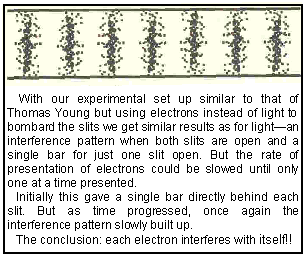|
Beyond Space, beyond any Thing.
First we need to know that there is an enormous size gap between the micro world of the atom and that world we normally think of as being microscopic--something visible under a microscope. With a very good microscope bacteria and other single cell organisms can become visible. Their size is mostly in the range 1-10 x 10-4 cm. An atom is about 10-8 cm; an atom's nucleus is about 10-13 cm; an electron about 10-21 cm. (10-6 = one 1 millionth; 10-9 = 1 billionth)
Perhaps our first intimations of the peculiarities of the quantum world came in the early 19th century when Britisher, Thomas Young, obtained unequivocal evidence that light had similar characteristics to what is observed in a pond of water when wave fronts emanating from different disturbances meet one another. Where their wave peaks meet, they reinforce. When trough meets peak, they cancel.
Young's concept of the underlying wave characteristics of light dominated physics for the next one hundred years. But then along came the young Einstein to throw a hammer in the works with his interpretation of the so-called photoelectric effect which implied that light also behaved as if it consisted of particles. It turned out that both Young and Einstein were right--light does behave both as a wave and as a particle.
The light particle is given the name "photon." It is also determined to be mass-less. So what about other sub-atomic particles, those that do have mass, and even electric charge, such as the electron for example?
Experiments of the same kind as Young's in which a narrow beam of electrons was passed through two parallel slits and then onto a screen gave the same result as Young obtained--an interference pattern of narrow bars interspersed by gaps. So electrons too, appear to have wave-like characteristics. However when electrons were used, it was also technically possible to slow their presentation rate until only one electron at a time was presented.
At first the result appeared to be that each electron registered on the screen as a single spot--that expected for particle-like behavior. But as time went by and thousands of spots accumulated on the screen, the result was extraordinary--a series of bars interspersed with gaps slowly built up (see below). And since each electron went through the slits, one at a time, for this pattern of light and dark bars to build up, each electron surely had to go through both slits and somehow interfere with itself!!
Many years of quite ingenious experimentation were required to catalogue what happens.
|
|





